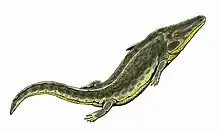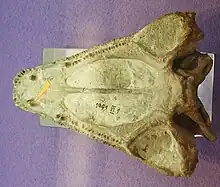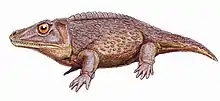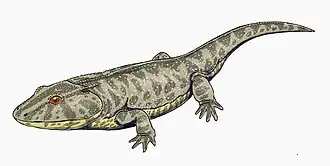| Benthosuchus Temporal range: Early Triassic, | |
|---|---|
 | |
| Skull of Benthosuchus sushkini | |
| Scientific classification | |
| Domain: | Eukaryota |
| Kingdom: | Animalia |
| Phylum: | Chordata |
| Class: | Amphibia |
| Order: | †Temnospondyli |
| Suborder: | †Stereospondyli |
| Family: | †Benthosuchidae Efremov, 1940 |
| Genus: | †Benthosuchus Efremov, 1937[1] |
| Species | |
| |


Benthosuchus (meaning "deep water crocodile") is an extinct genus of temnospondyl amphibian from the Early Triassic of Russia. It was primarily aquatic, living in rivers and lakes. Multiple species are known, with the largest reaching about 2.5 meters in length.
Russian paleontologist Ivan Yefremov [Efremov] called the genus Benthosaurus "deep water lizard" (from Ancient Greek βένθος (benthos) "depth, deep water") in his original 1929 description, "in view of its clearly indicated adaptation to life in deep water" shown by "the position of the orbits and the flatness of the skull." The type species B. sushkini honored his late teacher Petr Sushkin. The generic name was preoccupied by Benthosaurus Goode & Bean, 1886, a fish, and he renamed the genus Benthosuchus ("deep water crocodile") in 1937.[2][3]
Benthosuchus has traditionally been considered a member of the temnospondyl superfamily Trematosauroidea, and the family Benthosuchidae was established in 1940 to include Benthosuchus and the related trematosauroid Thoosuchus. Some recent phylogenetic studies have removed Benthosuchus from Trematosauroidea entirely, placing it as a closer relative of Mastodonsauroidea, another group of Triassic temnospondyls. Other studies retain Benthosuchus within Trematosauroidea, but since Benthosuchus and Thoosuchus have successively basal positions on these trees they form a paraphyletic grouping, not a valid clade.[4] In either case, Benthosuchidae is a monotypic family containing only Benthosuchus.
Description
Benthosuchus skull is about 0.75 m long (it is comparatively short in young individuals but lengthens with age), and the overall body length is about 2.5 m. It existed in widely overflowing rivers of the East Russian Depression.[5]
Phylogeny
Benthosuchus is traditionally considered a close relative of a group of temnospondyls called capitosaurids. In particular, it bears a close resemblance to the capitosaurid Wetlugasaurus. Many of the early large-scale phylogenetic analyses of temnospondyls place Benthosuchus within a clade called Capitosauria. However, more recent analyses such as that of Fortuny et al. (2011) recover Benthosuchus within another clade called Trematosauria. Occasionally it is grouped near the trematosaurid family Trematosauridae as a basal member of the group Trematosauroidea.[6] Fortuny et al. found that Benthosuchus positioned outside Trematosauroidea as a more basal trematosaurian. Below is a cladogram from Fortuny et al. (2011) showing the phylogenetic placement of Benthosuchus:[7]
| Stereospondyli |
| |||||||||||||||||||||||||||||||||||||||||||||||||||||||||||||||||||||||||||||||||||||||||||||||||||||||||||||||||||||||||||||||||||||||||||||||||||
References
- ↑ Igor Novikov (July 2012). "New data on trematosauroid labyrinthodonts of Eastern Europe: 4. Genus Benthosuchus Efremov, 1937". Paleontological Journal. 46 (4). doi:10.1134/S0031030112040089.
- ↑ Efremov, I. A. (1929). Benthosaurus sushkini, ein neuer Labyrinthodont der permotriassischen Ablagerungen der Sharschenga Flusses. Bulletin of the Academy of Sciences of the USSR 8:747-770. [English translation: https://paleoglot.org/files/Efremov%201929b.pdf]
- ↑ Efremov, I.A. (1937). On the Stratification of Continental Permian and Triassic the Soviet Union Based on the Terrestrial Vertebrate Fauna. Doklady Akademii Nauk SSSR. Nov. Ser. 16(2): 125–132.
- ↑ Damiani, R.J.; Yates, A.M. (2003). "The Triassic amphibian Thoosuchus yakovlevi and the relationships of the Trematosauroidea (Temnospondyli: Stereospondyli)" (PDF). Records of the Australian Museum. 55 (3): 331–342. doi:10.3853/j.0067-1975.55.2003.1388.
- ↑ "Benthosuchus". Retrieved Oct 16, 2020 – via The Free Dictionary.
- ↑ Shishkin, M.A.; Sulej, T. (2009). "Early Triassic temnospondyls of the Czatkowice 1 tetrapod assemblage" (PDF). Palaeontologica Polonica. 65: 31–77. Archived from the original (PDF) on 2012-03-01. Retrieved 2012-08-02.
- ↑ Fortuny, J.; Galobart, À.; Santisteban, C. D. (2011). "A New Capitosaur from the Middle Triassic of Spain and the Relationships within the Capitosauria". Acta Palaeontologica Polonica. 56 (3): 553. doi:10.4202/app.2010.0025.













